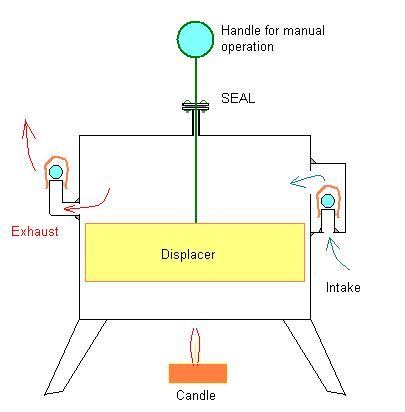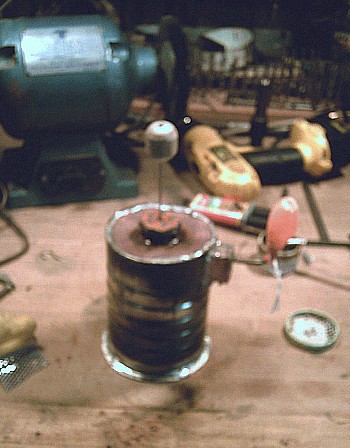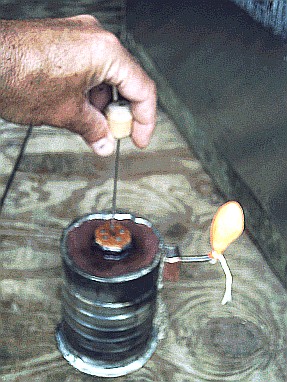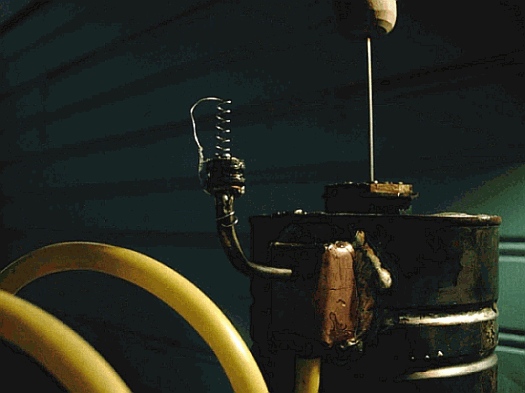Hi, I've been aware of the vortex tube for some time and thought there might be some way to utilize it, but see a number of problems.
1. Yes, the thing does separate compressed air into hot and cold, but, how is the air compressed in the first place? Usually with a shop compressor drawing 15 Amps or so. The compressed air then sits in a tank and returns to room temperature.
So... you stick a vortex tube on the end of a compressor hose and get one small stream of cold and one small stream of hot air but you have already WASTED an enormous amount of heat/energy to compress the air in the first place.
All the heat thrown off by the compressor before anything gets to the vortex tube is probably 1000X more energy than what you might get out of the vortex tube. I could not really figure out any way to derive any real power from a vortex tube in any way that would be practical.
Likewise, the heat boiling off the back of a refrigerator is generally not utilized in any way.
The intention is to utilize the Stirling principle to use heat to expand air and use the expanding air to compress more air which releases more heat which instead of going to waste is utilized to compress more air.
Basically you have a heat powered air compressor that runs off of its own "waste heat". The compressor does not "create" that "waste heat". The heat is already in the air being compressed.
Instead of throwing the heat away in the process of compressing the air you concentrate that heat with a "heat pump" and direct it back into the "compressor" which itself runs on that heat.
You draw in Ambient temperature air warmed by the sun. Instead of throwing all that heat away you "Squeeze" out the heat - or concentrate it in one area and use it to drive a heat driven compressor that continually draws in more and more warm air for "fuel".
Retain as much heat as needed to continue compressing more air and throw the rest away.
Heat does not drive the turbine. Heat (or a temperature differential) drives the compressor. The compressor gathers its own heat from the atmosphere.
First you use heat (or a temperature differential) to compress air. Retain some of the heat to increase the temperature differential somewhat, as much as necessary. But ultimately you want to convert that heat energy into
PRESSURE.
When the compressed air is released through a nozzle into the turbine the energy is in the form of VELOCITY. At this point you do not want heat. Just the opposite. Any heat not used by the "compressor" should either be reclaimed to run the compressor or thrown off before reaching the Turbine. The turbine runs on the high velocity of escaping
COOL compressed air.
The Cool compressed air expands through the turbine and gets
colder due to expansion and also due to the energy transfer. The energy of the high velocity air entering the turbine is converted into mechanical motion and finally into electricity to power some electrical load on the turbine. The result is
very cold air leaving the turbine.
The cold air from the turbine is then used as your "sink", which makes Ambient heat available to run the compressor - which runs on the resulting temperature differential.
So you have this conversion process: (edit: formatting was lost - see post below)
/Excess Heat Dissipation---->
/
\------Pressure > Velocity > Mechanical Motion > Electricity --- >>>
\ V V
\ Heat V
\ V Cold Air
->Heat in the air ---->(Heat Engine-Compressor) V
V
<----------------COLD AIR----------------------V
The Engine/Compressor is sandwiched between the Hot and Cold compression and expansion tubes.
The compressor utilizes the temperature differential between the concentrated Ambient Heat and the cold decompressed air leaving the turbine
Theoretically you are drawing on the vast reservoir of heat or solar energy stored in the atmosphere. To do that you have to end up with COLD AIR as a "sink" for the heat to flow towards. As some portion of heat energy is converted to electricity and leaves the system in that way, and other ways, there is little heat left over to be removed so as to maintain a sink for more Ambient heat to flow towards.
I think Nikola Tesla described this principle much more lucidly than I am able:
" This would be an inanimate engine which, to all evidence, would be cooling a portion of the medium below the temperature of the surrounding, and operating by the heat abstracted.
"...Conceive, for the sake of illustration, [a cylindrical] enclosure T, as illustrated in diagram b, such that energy could not be transferred across it except through a channel or path O, and that, by some means or other, in this enclosure a medium were maintained which would have little energy, and that on the outer side of the same there would be the ordinary ambient medium with much energy. Under these assumptions the energy would flow through the path O, as indicated by the arrow, and might then be converted on its passage into some other form of energy. The question was, Could such a condition be attained? Could we produce artificially such a "sink" for the energy of the ambient medium to flow in? Suppose that an extremely low temperature could be maintained by some process in a given space; the surrounding medium would then be compelled to give off heat, which could be converted into mechanical or other form of energy, and utilized. By realizing such a plan, we should be enabled to get at any point of the globe a continuous supply of energy, day and night. More than this, reasoning in the abstract, it would seem possible to cause a quick circulation of the medium, and thus draw the energy at a very rapid rate.
"Here, then, was an idea which, if realizable, afforded a happy solution of the problem of getting energy from the medium. But was it realizable? I convinced myself that it was so in a number of ways,... Heat, like water, can perform work in flowing down, ... But can we produce cold in a given portion of the space and cause the heat to flow in continually? ...Heat, though following certain general laws of mechanics, like a fluid, is not such; it is energy which may be converted into other forms of energy as it passes from a high to a low level.... If the process of heat transformation were absolutely perfect, no heat at all would arrive at the low level, since all of it would be converted into other forms of energy.... We would thus produce, by expending initially a certain amount of work to create a sink for the heat to flow in, a condition enabling us to get any amount of energy without further effort. This would be an ideal way of obtaining motive power. We do not know of any such absolutely perfect process of heat-conversion, and consequently some heat will generally reach the low level, ...But evidently there will be less to pump out than flows in, or, in other words, less energy will be needed to maintain the initial condition than is developed by the fall, and this is to say that some energy will be gained from the medium. What is not converted in flowing down can just be raised up with its own energy, and what is converted is clear gain. Thus the virtue of the principle I have discovered resides wholly in the conversion of the energy on the downward flow."
Tesla worked on this engine until; (so it is rumored) - J.P. Morgan ordered his workshop burned to the ground (though there was no evidence) and blacklisted him so that he could receive no more funding for his projects.
"... I was just beginning work on the third element, which together with the first two would give a refrigerating machine of exceptional efficiency and simplicity, when a misfortune befell me in the burning of my laboratory,..."
Tesla's Article with illustrations:
A DEPARTURE FROM KNOWN METHODS—POSSIBILITY OF A "SELF-ACTING" ENGINE —THE IDEAL WAY OF OBTAINING MOTIVE POWER.
http://www.tfcbooks.com/tesla/1900-06-00.htm
If I'm mistaken about the possibility of this working, at least I'm in good company, I guess.



